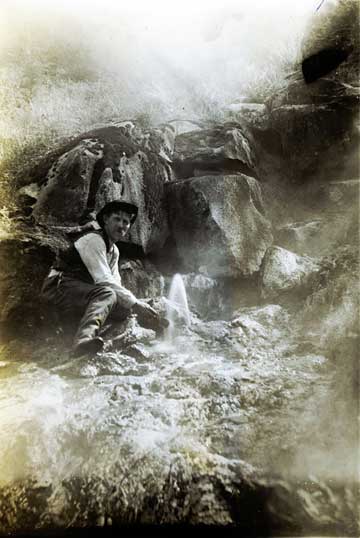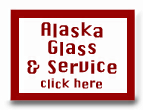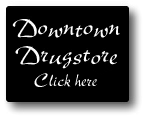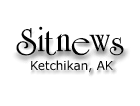 John Koel, Baker to Banker An eccentric philanthropist By June Allen September 07, 2004
He soon bought the building housing his bakery, added a small restaurant and rented out the second story as a rooming house. He chose to live in one of those modest upstairs rooms himself, his home for the rest of his life. Then in 1903, just two years after his arrival, he was able to buy the adjacent corner lot on Dock Street. There he built a concrete bank building, with a thick-walled vault included in the construction. It was the first reinforced concrete, fireproof commercial building not only in Ketchikan but in all of Alaska! The new structure was intended for the Miners & Merchants Bank -called the M&M - a financial enterprise founded by the small town's monetary leaders. The bankers promptly moved into their modern new building. Front Street was largely a rowdy waterfront boulevard of saloons and fly-by-night businesses. But parallel Main Street was the respectable avenue of city structures, business offices, and the fire hall. At the wide, oddly angled intersection of Dock and Main Street, Koel's corner was weighted with the Miners & Merchants Bank. Directly across Dock was J.R. Heckman's mercantile complex. Across Main was founder and first mayor Mike Martin's home and patriotic flagpole, with the Ladies Library building and twin City Council building on the right. And across Dock on the fourth corner was the big Red Men Hall and its associated smaller enterprises. On a lot at the next corner, of Main and Mission, Koel then built a two-story wooden building with shops down and rooms upstairs. He found time to serve a single term on the City Council in 1908-1909 as he continued to add to his business holdings. He also gained a reputation for being willing to loan money to young people and others who didn't qualify for a bank loan. He was a well-liked man. But in spite of his business success and his sterling reputation, today's oldtimers remember best the elderly John Koel of the 1930s and '40s, an aged man with a cane, who was addicted to movies and laughed uproariously at the antics on the silver screen! If he liked a movie, he'd see it night after night, always choosing to sit on the left side of the theater - where youngsters often chose to sit. His raucous and bizarre ho!-ho!-ho! laughter at the screen's heroes and villains is remembered by anyone who ever heard it! He laughed not only at the comic scenes but at tense or emotional moments as well, erupting with unexpected belly-laughs at tearfully touching or sentimental scenes. Westerns also tickled Koel's funny bone, especially during gunfights when cowboys and/or rustlers clutched their chests and bit the dust. 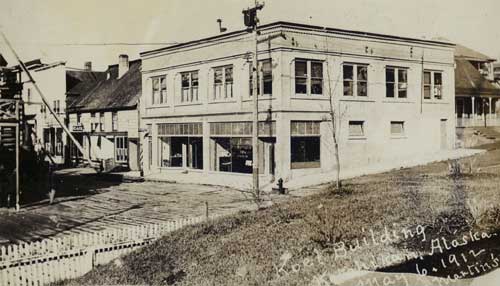 Intersection of Dock and Main Streets from Mike Martin's yard Donor: Bertha Hunt Wells, Photograph courtesy Tongass Historical Society
But in those early century days of establishing himself, Koel and other pioneer businessmen were concentrating not on entertainment but on establishing sound civic infrastructures. Much needed to be done in the rapidly growing frontier town. Creating and planking downtown streets was a priority. Ketchikan was - and still is - largely "hollow" under its streets that border the irregular tideland waterfront, built on piling over rising and falling tidewaters. Koel's new corner M&M Bank was built on solid rock but until 1905 the length of Main Street uphill from Dock Street was a deep gully of boulders and berry bushes with wooden sidewalks with handrails on either side of the "street" and a plank walkway "bridge" from one side to the other. It was up these sidewalks that children scampered to get to the town's school and grownups trudged to get to church and the several homes and other buildings along the way. In 1905 the street was upgraded to a real street, with planking assessed to property owners at $2.13 a foot. During that first decade of the century, Ketchikan was growing by leaps and bounds with critical need for every kind of housing. The elegant and turreted Stedman and Revilla Hotels both went up at mid decade. Mining promoter John Shoenbar got permission from the city to build a tramway from dockside and then down the first block of Market Street (now Mission Street) and up the hill to Bawden and out to border Ketchikan Creek on the Harris Street side. Mission Street was stretched to reach Stedman Street and the bridge and then out as far as New England Fish Co. It's safe to say that wherever a street was opened, homes and businesses soon lined it! 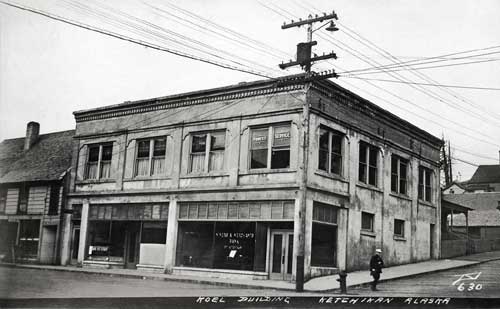 Photographer: David Nicoll Donor: Mrs. Al Hagmoe, Photograph Courtesy Tongass Historical Society
The town was so prosperous by 1920, in fact, that the Miners & Merchants Bank decided to build its own bank building just across Main Street on the large angled lot where Mike Martin's house stood. Martin had died in 1916. Whatever Martin's tie to the bankers, the lot was cleared and today's Commercial Building was constructed and the bank moved across the street in April of 1921. (The building now houses the Wells Fargo Bank.) John Koel was not happy about it! It became obvious that he had a vengeful streak in his nature. He apparently decided he'd give the M&M a little competition. He stepped up his activities of making "personal" loans. He helped young people to find jobs and he loaned them money. He let it be rumored that he was thinking of starting his own bank! And that's exactly what he did. Getting his own bank started was not as easy as he thought at first, and it took more time than anticipated, but a October 1924 Ketchikan Chronicle article reported: "Negotiations were under way for a considerable time before arrangements were completed and a charter for a national bank was obtained from the comptroller of currency. The charter was granted last month and it was expected that the bank would be able to start immediately." The charter was obtained in September 1924, marking the official beginning of the new national bank, to be called the First National Bank (now renamed First Bank). But an official grand opening was delayed by two problems. Shipment of new equipment for the bank was delayed. And Gus Pruell, who had been temporarily renting Koel's bank building for his jewelry business, was unable to move immediately into his planned new quarters in the brand new Ingersoll Hotel, being built on the ashes of the old Revilla Hotel. But the new bank was able to open Monday morning Oct. 20, 1924. The Chronicle described its "pleasing" interior as made of marble fixtures with mahogany woodwork. The article continued with the information that the new bank had a paid up capitalization of $50,000 and was ready to give general banking service to customers and had safety deposit boxes available. The first cashier was W.A. Pries. 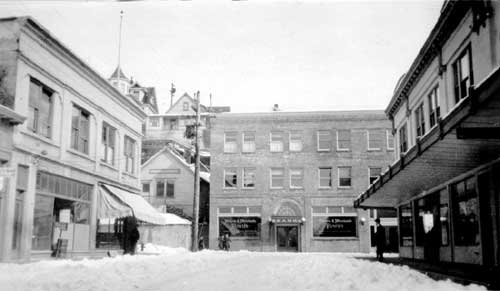 Photograph courtesy Tongass Historical Society
The effects of the stock market crash of 1929 that ushered in the Great Depression were slow to reach Ketchikan, but by 1932 they were being felt severely. Commerce slowed and construction slowed during the 1930s except for federal government projects - Ketchikan's being the dredging and creation of the Thomas Basin small boat harbor and the nearby Federal Building on Stedman Street. John Koel's obituary in the Ketchikan Daily News mentions that he was "instrumental in founding the First National Bank and was president of that institution for many years and had remained one of its largest stockholders." At war's end in 1945, John Koel was 82 years old and had to use that cane - the cane boys remembered as switching their ankles. The following year Koel died. Funeral services were held at the Elks Lodge. His pallbearers were Frank Bold, J.R. MacMillan, Bert R. Libe, J.E. Johnson and A.H. Ziegler. Honorary pallbearers were Pete Johnson, George Morrison, Tom Clemmenson and William Anderson. Many of Ketchikan's business houses closed for an hour in the afternoon in respect to the pioneer businessman. He was buried at Bayview Cemetery. John Koel left an estate of $25,000, equal to $242,300 in today's dollars. He also left, to the young people of Ketchikan, a bequest of $10,000 - equal to $96,920 in today's dollars. That money went for scholarships for Kayhi students and other services benefiting children and youth. So next time you pass the century-old First Bank building on the corner of Dock and Main, salute the old gentleman who gave it to us and who exemplified the spirit of Ketchikan: If you want something done, then DO it!
june@sitnews.org
All rights reserved. Not to be reprinted in any form without the written permission of June Allen.
|
